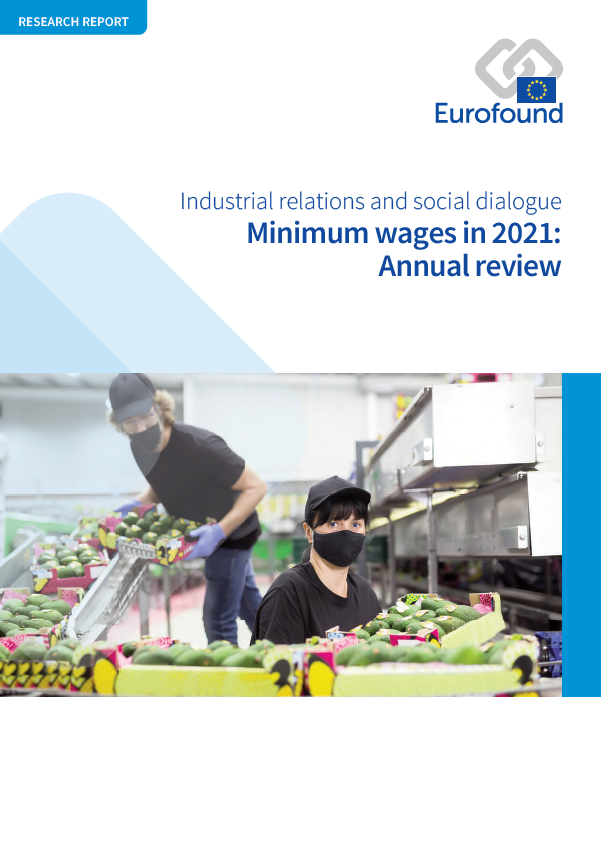Este relatório resume a forma como os índices salariais mínimos para 2021 foram definidos durante 2020, o ano marcado pela pandemia de COVID-19. Analisa as dificuldades enfrentadas pelos decisores nacionais e a forma como estes reagiram aos desafios económicos e sociais da pandemia aquando da tomada de decisões relativas ao salário mínimo. Identifica em que medida o salário mínimo foi abrangido pelas medidas de apoio relacionadas com a COVID-19 e discute os avanços realizados na iniciativa da UE sobre um salário mínimo adequado, congregando as reações dos parceiros sociais ao nível da UE e dos decisores nacionais. O relatório é acompanhado por dois documentos de trabalho complementares: um analisa os desenvolvimentos, ao longo da última década, para trabalhadores com baixos vencimentos e a ganharem o salário mínimo; o outro resume a investigação mais recente sobre os salários mínimos em países da UE, na Noruega e no Reino Unido.
Key findings
Os salários mínimos foram aumentados cautelosamente na maioria dos Estados-Membros de 2020 para 2021, com a média dos países a registar um aumento de 3 % (calculado em moedas nacionais). Apenas alguns Estados-Membros decidiram congelar o nível de salário mínimo em 2021, ao contrário do que aconteceu durante a crise financeira.
Em países sem salários mínimos nacionais (Áustria, Dinamarca, Finlândia, Itália, Suécia e Noruega), os aumentos salariais foram moderados, mas, em geral, as negociações revelaram-se razoavelmente estáveis. Como a negociação coletiva foi, em alguns casos, afetada pela pandemia, foram adiadas algumas renovações e aumentos salariais.
O principal desafio enfrentado pelos decisores durante as rondas de 2020 para definição do salário mínimo foi a incerteza económica geral que rodeou a pandemia. Mesmo podendo fazer previsões, estas eram mais incertas e voláteis do que o habitual.
As posições dos parceiros sociais sobre a proposta de diretiva relativa ao salário mínimo na UE permanecem inalteradas. Em termos gerais, as organizações de empregadores são mais críticas, preferindo uma recomendação desprovida de força vinculativa. A maioria dos sindicatos são a favor da iniciativa, mas gostariam que esta fosse mais longe. As posições dos governos são heterogéneas.
List of tables
The report has the following list of tables:
Table 1: Gross minimum wages, selected EU Member States and the UK, in € and national currencies, 2020 and 2021 compared
Table 2: Sub-minimum rates for selected EU Member States and the UK as of January 2021
Table 3: Occupational or sector-related statutory minimum wage rates in Cyprus, Malta and Romania, January 2021
Table 4: Seniority- or qualification-related top-ups of statutory minimum wage rates for private sector workers, January 2021
Table 5: Minimum wage rates related to level of hardship or job demands for private sector workers, January 2021
Table 6: Change in monthly minimum wages in collective agreements (%), between 1 January 2020 and 1 January 2021, for selected low-paid jobs (national currencies)
Table 7: Minimum wage setting for 2021 – Countries that followed previous commitments
Table 8: Minimum wage setting for 2021 – Countries that adhered to formulas
Table 9: Minimum wage setting for 2021 – Countries that fell short of previous targets
Table 10: Minimum wage setting for 2021 – Countries that opted for cautious increases
Table 11: Minimum wage setting for 2021 – Countries that froze the level or deferred decisions
Table 12: Change in the number of employees 2019 to 2020 and proportion of minimum wage workers, by sector
Table A1: Legal basis for statutory minimum wages
Table A2: Overview of changes to minimum wage regulations in 2020
Table A3: Wage rates in collective agreements related to 10 selected low-paid jobs, 2020 to 2021, in national currency
Table A4: Minimum wage references used in short-time working schemes or for subsidised employment
Table A5: References to the minimum wage determining the eligibility for income support when employed
Table A6: Minimum wage references used to determine the level of COVID-19-related benefits for self-employed people, working parents and others
Table A7: References to the minimum wage determining the eligibility to obtain certain benefits
Table A8: List of other COVID-19 EU PolicyWatch database cases referred to in this report by country
Table A9: Network of Eurofound Correspondents
List of figures
The report has the following list of figures:
Figure 1: Breakdown of national decision-makers interviewed, based on organisation type and system type (%)
Figure 2: Hourly minimum wages (€), selected Member States, 2021
Figure 3: Collectively agreed average or median monthly pay in 10 low-paid jobs, January 2021 (€)
Figure 4: Minimum wage setting for 2021 and the role of the social partners
Figure 5: Change in number of employees between 2019 and 2020 and proportion of minimum wage workers by occupation, men and women
Figure 6: Stances towards the proposed directive by respondent type (%)
Figure 7: Stances towards the proposed directive by type of wage setting (%)
- Number of pages
-
74
- Reference nº
-
EF21015
- ISBN
-
978-92-897-2172-1
- Catalogue nº
-
TJ-AS-21-001-EN-N
- DOI
-
10.2806/47491
- Permalink
Cite this publication
Eurofound (2021), Minimum wages in 2021: Annual review, Minimum wages in the EU series, Publications Office of the European Union, Luxembourg.

